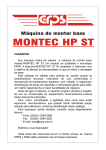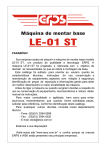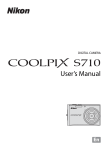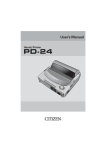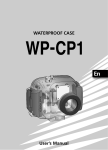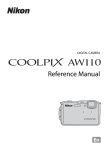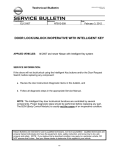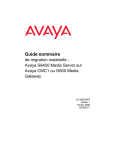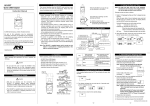Download Quick Start Guide - CNET Content Solutions
Transcript
Quick Start Guide Take the Camera out of the Box 3 First Steps 4 Shooting and Playback 9 Installing ViewNX 2 13 Using ViewNX 2 15 En Thank you for purchasing a Nikon COOLPIX S8100 digital camera. This guide introduces the procedures necessary in using this camera for the first time. For more detailed information, please refer to the supplied User’s Manual. Technical support information is available online at the following sites: • For users in the USA: http://www.nikonusa.com/ • For users in Europe and Africa: http://www.europe-nikon.com/support/ • For users in Asia, Oceania, and the Middle East: http://www.nikon-asia.com/ An Important Notice about Accessories Nikon COOLPIX digital camera is designed to the highest standards and includes complex electronic circuitry. Only Nikon accessories, such as battery chargers, batteries, Charging AC Adapter and AC adapters are certified by Nikon specifically for your Nikon COOLPIX camera and are engineered and tested to operate within the requirements of the electronic circuitry of our cameras. 2 Take the Camera out of the Box Remove the camera and accessories from the box and confirm that you have all the items listed below. COOLPIX S8100 Digital Camera Camera Strap USB Cable UC-E6 Audio Video Cable EG-CP16 Rechargeable Li-ion Charging AC Adapter Battery EN-EL12 EH-68P/EH-68P (AR)* (with terminal cover) ViewNX 2 installer CD • Quick Start Guide (this guide) • User’s Manual • Warranty * Plug adapter supplied only in countries or regions where required and its shape varies with country or region of purchase. The shape of the Charging AC Adapter EH-68P (AR) supplied in Argentina differs from that supplied in other countries (A6). NOTE: A Secure Digital (SD) memory card, hereafter referred to as a “memory card”, is not provided. Refer to page 184 in the User’s Manual for a list of approved SD memory cards. Parts of the Camera 1 2 3 4 14 5 6 7 13 8 12 1 2 3 4 5 6 7 Power switch/power-on lamp Mode dial Zoom control Shutter-release button Charge lamp/flash lamp b (movie-record) button c (playback) button 8 9 10 11 12 13 14 9 10 11 Rotary multi selector k (apply selection) button l (delete) button d button Battery-chamber/memory card slot cover Monitor Flash A: This icon indicates that more information is available elsewhere in this guide. Take the Camera out of the Box 3 First Steps Step 1 Attach the Camera Strap Step 2 Insert the Battery and Memory Card If a memory card is inserted, images will be saved on the memory card when you take pictures. If a memory card is not inserted, images will be saved in the camera’s internal memory (approximately 102 MB). 2.1 Open the battery-chamber/memory card slot cover. 2.2 Insert the supplied battery (EN-EL12). Battery chamber Use the edge of the battery to push the orange battery latch in the direction indicated by the arrow (1) and fully insert the battery (2). When the battery is fully inserted, the battery latch will lock it in place. Inserting the Battery Inserting the battery upside down or backwards could damage the camera. Be sure to check that the battery is in the correct orientation. 4 First Steps 2.3 Insert the memory card. Memory card slot Slide the memory card in until it clicks into place. Inserting Memory Cards Inserting the memory card upside down or backwards could damage the camera or the memory card. Be sure to check that the memory card is in the correct orientation. 2.4 Close the battery-chamber/memory card slot cover. Removing the Battery and Memory Card Turn the camera off and be sure that the power-on lamp and the monitor have turned off before opening the battery-chamber/memory card slot cover. The battery or memory card may be hot immediately after using the camera. Observe caution when removing the battery or memory card. Removing the Battery To eject the battery, open the battery-chamber/ memory card slot cover and slide the orange battery latch in the direction indicated by the arrow (1), then remove the battery while being careful not to remove the battery at an angle (2). Removing the Memory Card Press the card in (1) to partially eject the card, then remove the card by hand while being careful not to remove the card at an angle (2). Pages 12, 13, 20, and 21 of the User’s Manual First Steps 5 Step 3 Charge the Battery Use the supplied Charging AC Adapter EH-68P and USB Cable UC-E6 to charge the supplied Rechargeable Li-ion Battery EN-EL12 while it is in the camera. 3.1 Prepare the Charging AC Adapter EH-68P. If a plug adapter* is included, attach the plug adapter to the plug on the Charging AC Adapter. Push the plug adapter firmly until it is securely held in place. Once the two are connected, attempting to forcibly remove the plug adapter could damage the product. * The shape of the plug adapter varies according to the country or region in which the camera was purchased. For Customers in Argentina If the camera was purchased in Argentina, a plug adapter is not supplied. Proceed to step 3.2. EH-68P (AR) 3.2 Be sure that the power-on lamp and the monitor are off. Be sure to insert the battery into the camera and turn off the camera (A12). 3.3 Use the supplied USB cable to connect the Charging AC Adapter to the camera. USB cable 3.4 Plug the Charging AC Adapter into an electrical outlet. The charge lamp slowly blinks green to indicate that the battery is charging. Charging is complete when the charge lamp turns off. About three hours and 50 minutes are required to charge a fully exhausted battery. 3.5 Disconnect the Charging AC Adapter from the electrical outlet and then disconnect the USB cable. Pages 14-16 of the User’s Manual 6 First Steps Step 4 Turn On the Camera Press the power switch to turn on the camera. • The power-on lamp (green) will light, and then the monitor will turn on (the power-on lamp turns off when the monitor turns on). C Power Saving Function (Auto Off) If no operations are performed for a while, the monitor will turn off, the camera will enter standby mode, and the power-on lamp will blink. If no operations are performed for another three minutes, the camera will turn off automatically. When the power-on lamp is blinking, the following operations will turn the monitor back on. - Pressing the power switch, shutter-release button, c button, or b (movie-record) button - Rotating the mode dial Step 5 Choose a Language and Set the Camera Clock When the first time the camera is turned on, the language-selection screen and the date and time setting screen for the camera clock are displayed. Use the rotary multi selector to make the settings. The Rotary Multi Selector Press the rotary multi selector up, down, left, or right, or press the k button. Items can also be selected by rotating the rotary multi selector. Move the highlight up Return to the previous screen (move the highlight to the left) Move the highlight down 5.1 5.2 Rotate to select an item Advance to the next screen (move the highlight to the right) Apply selection Date Set time and date? Yes No Cancel Press H, I, J, or K to choose the desired language and press the k button. Press H or I to choose Yes and press the k button. First Steps 7 5.3 London Casablanca Back Press J or K to choose your home time zone and press the k button. 5.4 Daylight Saving Time If daylight saving time is in effect, press H to enable the daylight saving time function. • When the daylight saving time function is enabled, W is displayed at the top of the monitor. • Press I to disable the daylight saving time function. 5.5 Date Date D M Y D M Y 01 01 2010 15 11 2010 00 00 15 10 Edit Edit the date and time. • Choose an item: Press K or J (changes between D, M, Y, hour, minute, DMY (the order in which the day, month, and year are displayed)). • Edit the highlighted item: Press H or I. Edit Finally, choose DMY (the order in which the day, month, and year are displayed) and press the k button. • The clock starts. The lens extends and the screen used for taking pictures is displayed. C Imprinting the Date on Images While Taking Pictures After setting the date and time, enable date imprint from the Date imprint option in the z (setup) menu. Display the z (setup) menu using the following procedure and change the settings. Press the d button ➝ press the rotary multi selector J ➝ press H or I to select the z (setup) tab and press the k button ➝ press H or I to select an item and press the k button. Pages 158 and 165 of the User’s Manual C Changing the Current Date, Time, or Language Just as described under “Imprinting the Date on Images While Taking Pictures” above, display the z (setup) menu and set Language or Date. • To set the time zone or daylight saving time settings, select Time zone from the Date option. Pages 160 and 173 of the User’s Manual The next step explains basic shooting operations using A (auto) mode. 8 First Steps Shooting and Playback Step 1 Rotate the Mode Dial and Align the A (Auto) Icon to the Mark Auto mode Step 2 Check the Battery Level and the Number of Exposures Remaining Battery level indicator Battery level indicator Description (NO INDICATOR) Battery fully charged. B (glows) Battery low. Prepare to charge or replace battery. N Cannot take pictures. Recharge or Battery exhausted. replace with a fully charged battery. Pages 22 and 23 of the User’s Manual 35 Number of exposures remaining When the camera’s internal memory is being used, C appears. Shooting and Playback 9 Step 3 3.1 Frame a Picture Use both hands and ready the camera. Flash Do not hold the flash down with your fingers or other objects. Keep fingers and other objects away from the lens, etc. 3.2 Frame a picture. Point the camera at the object (subject) you want to take a picture of. If the camera detects a face, a square double border is displayed around the face. If more than one face is detected, a double border is displayed around the face closest to the camera, and single borders are displayed around the other faces. Using the Zoom Rotate the zoom control. • To zoom in closer to the subject: rotate the zoom control to g (telephoto). • To zoom out and view a larger area: rotate the zoom control to f (wide-angle). When the camera is turned on, the zoom is at the widest position. Pages 24 and 25 of the User’s Manual 10 Shooting and Playback 35 Step 4 4.1 Focus and Shoot Press the shutter-release button halfway, stopping when you feel resistance. If the camera detects a face in step 3: • The camera focuses on the area indicated by the yellow double border (focus area), and the double border changes to green. If the camera does not detect any faces: • The camera has nine focus areas, and automatically selects the focus areas containing the subject closest to the camera. When the subject is in focus, g (focus areas) glow green to indicate the areas of the frame that the camera is focusing on (up to nine areas). • When the camera is unable to focus, the focus area will blink red. Modify the composition and press the shutter-release button halfway again. • If the subject is dimly lit, the AF-assist illuminator may light and the flash may pop up. Flash lamp Focus area 1/250 Shutter speed F 3.5 Aperture AF-assist illuminator Flash lamp The flash lamp indicates flash status when the shutter-release button is pressed halfway. On Flash will fire when picture is taken. Blinks Flash charging.* Off Flash will not fire when picture is taken. * If the battery is low, the monitor display will turn off, and remain off, until the flash is fully charged. 4.2 Smoothly press the shutter-release button the rest of the way down to take the picture. The shutter is released and the image will be saved to the memory card or internal memory. Do not use force when pressing the shutter-release button, as this may cause camera shake, resulting in blurred images. Pages 26 and 27 of the User’s Manual Shooting and Playback 11 Step 5 Playback Images Press the c (playback) button. The camera enters playback mode. • The last image captured is displayed in fullframe playback mode. • Press the k button to display the shooting information screen. Press the k button again to return to full-frame playback. • To display previous or next images, rotate the rotary multi selector or press H, J, I, or K. • To return to shooting mode, press the c button again or press the shutter-release button or b (movie-record) button. b (movie-record) button 15/11/2010 15:30 0004.JPG 4/ 4 Display previous images Display next images Deleting Unwanted Images To delete the image currently displayed in the monitor, press the l (delete) button. When the deletion screen is displayed, press the rotary multi selector H or I to select Current image and press the k button. When the confirmation dialog is displayed, press H or I to choose Yes and press the k button to delete the image that is displayed. • After pressing the l button, press H or I to choose Erase selected images and choose multiple images to be deleted. Choose All images to delete all images. • Deleted images cannot be restored. To cancel it, choose No in the confirmation dialog and press the k button. 15/11/2010 15:30 0004.JPG Pages 28 and 29 of the User’s Manual Step 6 Turn Off the Camera Press the power switch to turn the camera off. • If the flash is raised, lower the flash by gently pushing it down, being careful not to pinch fingers or other objects. 12 Shooting and Playback 4/ 4 Delete Current image Erase selected images All images Installing ViewNX 2 Install the supplied software to display and edit photographs and movies that have been copied to your computer. Before installing ViewNX 2, confirm that your computer meets the system requirements (A19). Your Imaging Toolbox Step 1 ViewNX 2™ Start the Computer and Insert the Installer CD Windows Mac OS Double-click icon on desktop Double-click Welcome icon Installing ViewNX 2 13 Step 2 Select a Language If the desired language is not available, click Region Selection to choose a different region and then choose the desired language. 1 Select region (if required) 2 Select language 3 Click Next Step 3 Start the Installer Click Typical Installation (Recommended) and follow the on-screen instructions. Click Typical Installation (Recommended) C Installation Guide Click Installation Guide to display help information about installing ViewNX 2. Step 4 Exit the Installer Windows Mac OS Click Yes. Click OK. The following software is installed: • ViewNX 2 • Apple QuickTime (Windows only) • Panorama Maker 5 Step 5 14 Remove the Installer CD from the CD-ROM Drive Installing ViewNX 2 Using ViewNX 2 Step 1 Copy Images to the Computer 1.1 Turn off the camera. 1.2 Connect the camera and computer with the supplied USB cable. Confirm that the connector is properly oriented and then gently insert the connector, making sure that the connector is not inserted at an angle. When disconnecting, make sure that the connector is not removed at an angle. The camera automatically turns on and the power-on lamp lights. The camera monitor will remain off. When the action selection dialog is displayed on the computer, select Nikon Transfer 2. When Using Windows 7 When the screen shown below is displayed, use the following procedure to select Nikon Transfer 2. 1 Select Nikon Transfer 2 as the program specified for Import pictures and videos. • Click Change program under Import pictures and videos, and then choose Import File using Nikon Transfer 2 in the next screen and click OK. 2 Double-click Import File. Using ViewNX 2 15 B Starting Nikon Transfer 2 If there are a large number of images on the memory card, it may take some time for Nikon Transfer 2 to start. B Powering the Camera During Image Transfer • When connecting the camera to a computer to transfer images, use a fully charged battery to prevent the camera from turning off unexpectedly. • When the camera is connected to a computer via the supplied USB cable with Auto (default setting) selected for the Charge by computer option in the setup menu, the battery inserted into the camera is automatically charged. The charge lamp blinks slowly while the battery is charging. Pages 150 and 174 of the User’s Manual C Transferring Images Using a Commercially-available Card Reader or a Computer’s Card Slot The following methods can also be used to transfer images saved on a memory card to a computer. • Insert the memory card directly into the computer’s card slot. • Connect a commercially-available card reader to the computer, and then insert the memory card. 1.3 Confirm that the correct source is selected. Confirm that the camera or removable disk appears as a device button in the “Source” panel of the Nikon Transfer 2 “Options” area. Device button 1.4 Click Start Transfer. At default settings, all the images on the memory card will be copied to the computer. Click Start Transfer 16 Using ViewNX 2 1.5 Terminate the connection. If the camera is connected to the computer, turn the camera off and disconnect the USB cable. If you are using a card reader or card slot, choose the appropriate option in the computer operating system to eject the removable disk corresponding to the memory card and then remove the card from the card reader or card slot. Step 2 View Images When image transfer is complete, ViewNX 2 starts automatically and transferred images are displayed. C Starting ViewNX 2 Manually • Windows: Double-click the ViewNX 2 shortcut icon on the desktop. • Mac OS: Click the ViewNX 2 icon in the Dock. Using ViewNX 2 17 Retouching Photographs Click Edit in the ViewNX 2 toolbar. Images can be edited by using tone compensation, adjusting sharpness, trimming (cropping) images, etc. Editing Movies Click Movie Editor in the ViewNX 2 toolbar. Movies recorded with this camera can be edited by deleting unwanted sections of movies, etc. Printing Images Click Print in the ViewNX 2 toolbar. A dialog is displayed and images can be printed using a printer connected to the computer. C For Details About Using ViewNX 2 Refer to the ViewNX 2 help information. 18 Using ViewNX 2 C System Requirements Windows CPU OS RAM Hard-disk space Monitor Mac OS • Photographs/JPEG movies: • Photographs/JPEG movies: PowerPC G4 (1 GHz or better), G5, Intel Celeron/Pentium 4, or Intel Intel Core series, or Xeon series Core series,1.6 GHz or better • H.264 movies: • H.264 movies: - Playback: PowerPC G5 Dual or - Playback: 3.0 GHz or better Core Duo, 2 GHz or better Pentium D - Editing: 2.6 GHz or better Core 2 - Editing: 2.6 GHz or better Core 2 Duo Duo Pre-installed versions of Windows 7 Home Basic/Home Premium/ Professional/Enterprise/Ultimate, Windows Vista Home Basic/Home Premium/Business/Enterprise/ Mac OS X version 10.4.11, 10.5.8, or Ultimate (Service Pack 2), or Windows 10.6.4 XP Home Edition/Professional (Service Pack 3) All installed programs run as 32-bit applications in 64-bit editions of Windows 7 and Windows Vista. • Windows 7/Windows Vista: 1 GB or more (1.5 GB or more recommended) • Windows XP: 512 MB or more (1 GB or more recommended) 512 MB or more (1 GB or more recommended) A minimum of 500 MB available on the startup disk (1 GB or more recommended) Resolution: 1024 × 768 pixels (XGA) or more Colors: 24-bit color (True Color) or more Resolution: 1024 × 768 pixels (XGA) or more Colors: Millions or more Using ViewNX 2 19 Other Features of the COOLPIX S8100 Shooting mode Rotate the mode dial to select various shooting modes. In x scene auto selector, y, j night landscape, e night portrait, or R backlighting, camera settings are automatically optimized for the selected scene. In s subject tracking mode, the focus area will automatically move to track the subject. In C continuous shooting mode, images can be captured continuously at high speeds. Page 42 of the User’s Manual Movie recording Movies can be recorded in high definition. Movies can be recorded in slow motion or in fast motion. Page 129 of the User’s Manual h Favorite pictures, F Auto sort, C List by date mode After shooting, images added to the album can be played back. Images can be found by the category into which they were automatically sorted or by selecting the shooting date. Pages 92, 100, and 104 of the User’s Manual PictBridge Print images directly from the camera with connection to a PictBridge-compatible printer. Page 151 of the User’s Manual Printed in Hong Kong CT0I01(11) 6MM86911-01






















